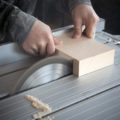Cutting wooden dowels is a common task in woodworking, but not everyone has access to a saw. Fortunately, there are several ways to cut wooden dowels without a saw, and in this article, I will share some of the most effective methods.
Before we dive into the techniques for cutting dowels without a saw, it’s important to understand the basics of dowel cutting. Dowels are cylindrical rods made of wood, and they are commonly used in woodworking projects to join two pieces of wood together. Cutting dowels to the right length and size is crucial for a successful woodworking project.
In this article, I will cover various tools and techniques for cutting dowels without a saw, as well as tips for preparing the dowel for cutting and finishing the cut. Whether you’re a beginner or an experienced woodworker, these methods will help you cut wooden dowels with precision and ease.
Understanding the Basics of Dowel Cutting
As a woodworker, I know that cutting dowels is an essential skill that every woodworker should master. While a saw is the most common tool used to cut dowels, there are several other methods that can be used to achieve the same results. In this section, I will share some basics of dowel cutting to help you get started.
Wooden Dowel
A wooden dowel is a cylindrical rod made of wood that is used in various woodworking projects for joining two pieces of wood together. Dowels come in various sizes, ranging from 1/8 inch to 2 inches in diameter, and are available in different wood species such as pine, oak, and maple.
Measurements
Before cutting a dowel, it is essential to take accurate measurements to ensure that the dowel fits perfectly into the intended space. Use a ruler or a caliper to measure the diameter of the dowel and mark the cutting point with a pencil or a marker.
Technique
There are several techniques that can be used to cut dowels without a saw. One common method is using a sharp knife to score the dowel at the mark and then making 1-3 cuts straight down the dowel. Another method is using a lathe to cut the dowel accurately. The lathe can help you achieve precise results, but it requires some experience and skill to use.
Precision
Precision is key when cutting dowels, especially when using alternative methods. Take your time and ensure that your measurements are accurate and that you cut the dowel precisely.
Dowel Size
The size of the dowel will determine the method you use to cut it. For smaller dowels, a sharp knife or a pair of scissors can be used to cut them. For larger dowels, a lathe or a hand saw may be necessary to achieve accurate results.
By understanding the basics of dowel cutting, you can confidently cut dowels without a saw and achieve precise results. Remember to take accurate measurements, use the right technique, and take your time to ensure precision.
Tools for Cutting Dowels
When it comes to cutting dowels without a saw, there are several tools you can use. The choice of tool depends on the size and thickness of the dowel, as well as the precision and accuracy required for the project. Here are some of the most common tools for cutting dowels:
Hand Saw
A hand saw is a versatile tool that can be used to cut dowels of various sizes. It is easy to use and can be used to make straight or angled cuts. However, it requires some skill and practice to make precise cuts.
Utility Knife
A utility knife is a handy tool for cutting dowels without a saw. It is easy to use and can be used to make clean and precise cuts. However, it is not suitable for cutting thick or hard dowels.
Chisel
A chisel is a sharp tool that can be used to cut dowels by hand. It is ideal for making precise cuts and shaping the dowel. However, it requires some skill and practice to use a chisel effectively.
Drill
A drill can be used to make holes in dowels, which can then be used as a guide for cutting the dowel. This method is ideal for making precise cuts and can be used to cut dowels of various sizes.
Hammer and Chisel
A hammer and chisel can be used to cut dowels by hand. The chisel is used to make a groove in the dowel, which is then split using the hammer. This method is ideal for cutting thick or hard dowels, but it requires some skill and practice.
Lathe
A lathe is a machine that can be used to cut dowels with precision and accuracy. It is ideal for cutting dowels of various sizes and shapes, and can be used to make intricate designs. However, it is an expensive tool and requires some skill and practice to use effectively.
Alternative Tools
There are several alternative tools that can be used to cut dowels without a saw, such as a serrated knife, a file, or a string. These tools can be used in a pinch, but they are not as precise or efficient as the tools mentioned above.
In conclusion, there are several tools that can be used to cut dowels without a saw. The choice of tool depends on the size and thickness of the dowel, as well as the precision and accuracy required for the project. With the right tool and some practice, cutting dowels can be a quick and easy task.
Cutting Dowels Without a Saw
https://www.youtube.com/watch?v=6tyygJh8c8s&embed=true
Cutting dowels without a saw may seem challenging, but it is possible with the right tools and techniques. Here are some methods that I have found to be effective:
Using a Knife
A sharp knife can be used to cut a wooden dowel. First, clamp the dowel in place to prevent it from rolling or moving. Then, score the dowel with the knife along the line where you want to make the cut. Continue scoring until you have made a deep enough groove to snap the dowel cleanly along the line.
Using an Axe or Machete
If you don’t have a saw, an axe or machete can be used to cut the dowel. First, secure the dowel in place using a clamp or vise. Then, use the axe or machete to chop the dowel along the line where you want to make the cut. Be sure to use caution and wear protective gear when using these tools.
Using a Lathe
A lathe is a tool that can be used to cut wooden dowels without a saw. First, measure and mark the dowel where you want to make the cut. Then, secure the dowel in the lathe and use a cutting tool to shape the dowel along the marked line.
Using Alternative Tools
There are several alternative tools that can be used to cut wooden dowels without a saw. These include a utility knife, chisel, or even a serrated garden shears. Each tool has its own advantages and disadvantages, so choose the one that works best for you.
In conclusion, cutting wooden dowels without a saw is possible with the right tools and techniques. Whether you use a knife, axe, lathe, or alternative tool, be sure to take the necessary safety precautions and work carefully to achieve the desired results.
Preparing the Dowel for Cutting
Before cutting the wooden dowel without a saw, it is important to prepare it properly. The following steps will help you prepare the dowel for cutting:
1. Measure the Dowel
The first step is to measure the length of the dowel. Use a ruler or measuring tape to ensure that the dowel is the correct length for your project. It is important to measure the dowel accurately to avoid any mistakes in the cutting process.
2. Score the Dowel
Once you have measured the dowel, use a sharp tool to score it at the point where you want to make the cut. Scoring the dowel will help guide the cutting tool and ensure a clean cut. Use a knife or any other sharp tool that you have available.
3. Choose a Cutting Tool
There are several tools that you can use to cut the dowel without a saw. Some of the most common tools include a sharp knife, garden shears, or a lathe. Choose the tool that you are most comfortable using and that will give you the most accurate cut.
Remember to always use sharp tools when cutting the dowel, as dull tools can cause the wood to splinter and create an uneven cut.
By following these steps, you can prepare the wooden dowel for cutting without a saw. With the right tools and techniques, you can create accurate and clean cuts that will help you complete your woodworking project with ease.
Finishing the Cut
https://www.youtube.com/watch?v=OlIluW6Cmq8&embed=true
Once you’ve made your cut, you may notice some rough edges or splinters on the dowel. To ensure a smooth finish, you can use sandpaper or a file.
If you’re using sandpaper, wrap it around the dowel and gently sand the edges until they are smooth. Start with a coarse grit sandpaper and gradually move to a finer grit for a smoother finish.
Alternatively, you can use a file to smooth out the edges. A flat file is best for this task, as it will allow you to create a flat edge on the dowel. If you need to create a curved edge, you can use a round file.
It’s important to note that when using a file, you should always file in one direction only. Filing back and forth can cause the file to become clogged and can also create an uneven edge.
Once you’ve finished sanding or filing, your dowel should have a smooth, even finish. This will not only make it easier to work with, but will also reduce the risk of splinters when handling the dowel.
In summary, finishing the cut is an important step in creating a smooth and even dowel. Sandpaper and a file are both effective tools for achieving this, and it’s important to use them correctly to avoid damaging the dowel.
Addressing Common Issues
Cutting wooden dowels without a saw can be a bit tricky, but with the right techniques, it can be done easily. However, there are a few common issues that you may encounter while cutting wooden dowels that you need to be aware of. In this section, I will address some of these issues and provide you with tips on how to avoid them.
Joints and Cracks
One of the most common issues that you may encounter while cutting wooden dowels is joints and cracks. These can occur when the dowel is not straight or when it has knots. When you encounter a joint or crack, it is best to avoid cutting through it as it can cause the dowel to split. Instead, you can try to cut the dowel on either side of the joint or crack. This will help you to avoid any damage to the dowel.
Tips and Warnings
When cutting wooden dowels without a saw, there are a few tips and warnings that you need to keep in mind. First, always wear protective gear such as gloves and safety glasses to avoid any injuries. Second, use a sharp knife or a chisel to cut the dowel as it will help you to make a clean cut. Third, make sure that you mark the dowel accurately before cutting it to avoid any mistakes. Finally, always cut the dowel slowly and carefully to avoid any accidents.
Gaps
Another issue that you may encounter while cutting wooden dowels is gaps. These can occur when the dowel is not cut straight or when it is not the right size. To avoid gaps, you can use sandpaper to smooth out any rough edges. You can also use wood filler to fill in any gaps that you may encounter.
In conclusion, cutting wooden dowels without a saw is possible, but it requires a bit of practice and patience. By following the tips and warnings provided in this section, you should be able to avoid any common issues that you may encounter while cutting wooden dowels.
Applying Dowel Cutting Techniques in Woodworking
https://www.youtube.com/watch?v=i6LI5wnBZas&embed=true
As a woodworker, I know the importance of having the right tools for the job. However, sometimes we may not have access to a saw, or we may need to cut dowels in an area where using a saw is not possible. In such cases, there are several techniques that we can use to cut dowels without a saw.
One of the most popular techniques for cutting dowels without a saw is using a cutting jig. A cutting jig is a device that helps you hold the dowel in place while you cut it with a knife or a sharp blade. This method is popular because it is accurate and produces clean cuts. It is especially useful when you need to cut many dowels of the same size.
Another technique for cutting dowels without a saw is using a serrated knife. A serrated knife has teeth that grip the wood, making it easier to cut through the dowel. This method is suitable for cutting dowels of small sizes, and it is also useful when you need to make precise cuts.
If you do not have a serrated knife or a cutting jig, you can use garden shears to cut dowels. Garden shears are useful for cutting dowels of larger sizes, and they produce clean cuts. However, you need to be careful when using garden shears as they can easily crush the wood.
Cutting dowels without a saw is useful in many woodworking projects, especially when you need to create screw holes or when you want to reinforce weak or damaged areas in furniture. Pine and hardwood are common types of wood used in dowel cutting, but you can also use other types of lumber depending on the project you are working on.
In conclusion, cutting dowels without a saw is possible using different techniques such as a cutting jig, serrated knife, or garden shears. Each method has its advantages and disadvantages, and you should choose the one that best suits your needs. With these techniques, you can create clean and precise cuts in your woodworking projects.
Frequently Asked Questions
What are some alternatives to using a saw to cut wood dowels?
If you don’t have access to a saw, there are several alternatives that you can use to cut wooden dowels. These include using a sharp knife, scissors, a box cutter, or a rotary cutter. You can also use a lathe, a dowel cutter, or a dowel jig. Each of these methods has its own advantages and disadvantages, so you should choose the one that works best for you.
Is it possible to cut wooden dowels with scissors?
Yes, it is possible to cut wooden dowels with scissors, but it can be difficult to get a straight and clean cut. You should use a pair of sharp scissors and make small cuts at a time. You can also use sandpaper to smooth out the edges of the dowel after cutting.
What is the best tool for cutting dowels?
The best tool for cutting dowels will depend on the size and type of dowel you are working with. For small dowels, a sharp knife or scissors may work well. For larger dowels, a handsaw or a jigsaw may be more effective. A dowel cutter or a dowel jig can also be used for more precise cuts.
How do you cut wooden dowels at home without a saw?
If you don’t have a saw at home, you can use a sharp knife or scissors to cut wooden dowels. You can also use a box cutter or a rotary cutter. Another option is to use a dowel cutter or a dowel jig. These tools are designed to make precise cuts in wooden dowels and are easy to use.
What is a dowel cutting jig and how does it work?
A dowel cutting jig is a tool that is used to make precise cuts in wooden dowels. It works by holding the dowel in place and guiding a saw blade or other cutting tool along a predetermined path. This ensures that the cut is straight and accurate every time. Dowel cutting jigs can be purchased at most hardware stores or online.
Can a circular saw be used to cut dowels effectively?
Yes, a circular saw can be used to cut dowels effectively, but it may not be the best tool for the job. Circular saws are designed for cutting larger pieces of wood and may not be as precise as other cutting tools. If you do use a circular saw, make sure to use a fine-toothed blade and take your time to ensure a clean and accurate cut.

Hi, I’m Sal Muller of Tooltrip.com. My DIY experience led me to understand essential power tools for home projects. Tooltrip.com guides enthusiasts and professionals in choosing right tools for any job. I provide concise top tool reviews for easier, efficient DIY.








